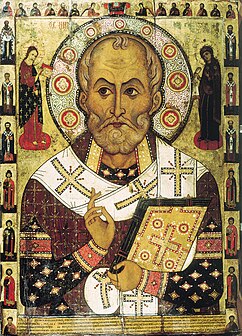
Advent is in its second week, by the church and its calendar it is a reflective; promising time. Outside, the holidays have picked up energy. The shopping season is in full swing. Stores are draped in glittering things, reams of wrapping paper roll like waves, everywhere are Christmas displays and pine trees are, lately, a weirdly common species in Southern California. All around is a tidal surge of ads. Buy! Buy! Buy! They cry; this is the season for consumption. We are asked to perform a patriotic chore and lift the ship of state by buying gifts. For more motivation there are ads, promising and pushing gifts; inspiring guilt; envy and desire. Finally there is Santa Claus. Santa Claus might be the shopping season’s mascot. He is the jolliest man in the world, the once a year bringer of gifts and cheer. Santa Claus is more than a mascot though, he is a myth. Like many myths, Santa Claus descends from a real man whose story can tell us much about giving and receiving gifts.
 |
| St. Nicholas “Lipensky” (1294 Russian icon) |
Santa Claus was originally Nicholas, bishop of Myra. Nicholas was a Greek born in Roman ‘Asia’. He was raised in a devoutly Christian family when Christianity was an illegal, persecuted sect. In his youth he was ordained a priest. Then sometime after the Roman emperor Constantine converted to Christianity and legalized it, Nicholas was elevated bishop of Myra, a port city in what is today Turkey. He was a great wonderworker and for those works, Nicholas was sainted. But it is his gift giving that is remembered today.
In America gift giving is nearly all that is remembered of Saint Nicholas. It was more than a thousand years before Nicholas, sainted bishop of Myra, became the Santa Claus we know today. Many generations passed after Saint Nicholas’ death before accounts of his life arrived in England. By then Saint Nicholas was called Santa Claus, an English translation of a Dutch name that was a corruption of the original Greek. In the medieval era Saint Nicholas, or Santa Claus, was well recognized in Britain. That long ago, the most popular wonder ascribed to Saint Nicholas was raising three butchered boys from the dead. It was no small feat. A particularly greedy butcher had cut the boys into parts and pickled them, intent to capitalize on the astronomical price of meat during a famine. Saint Nicholas recognized the deceit and resurrected the boys with prayer; apparently they came out complete in all their parts, and ruined the butcher’s reputation. Generations later the myth of Santa Claus followed English colonists and their church to America. The memorable and grisly legend of the restored butchered boys was largely lost along with much of the traditional narrative of Saint Nicholas’ life.
Finally, through the alchemy of advertising, the Santa Claus we know today was created. The tall; stiff bishops hat Saint Nicholas once wore became floppy and acquired a cotton tail; his red robes, once an image of power, were reimagined as a jolly red suit, fur lined and completed by tall black boots. Short, slender and sever Saint Nicholas, bishop of Myra was transformed. In America he was, and remains, Jolly Old St. Nick. Much was lost in translation.
In life Saint Nicholas was a gift giver very different from our American Santa Claus and that tradition of Saint Nicholas’ life has much to teach. As bishop and long after his death Saint Nicholas was most known for a miracle that saved Myra from famine. There was great hunger and suffering in Myra and all of Roman ‘Asia’ when a grain ship, bound to restore the stores of the capital Constantinople, stopped in the Myra’s port. Nicholas, then the bishop, asked the sailors of that ship to unload a large quantity of grain—two years’ worth which also included seed for planting in future seasons, to feed the hungry of Myra. Saint Nicholas promised that, even after generously giving so much grain, when the ship arrived in Constantinople the sailors would find it full. Reluctantly the sailors agreed. Myra was fed through the famine and when the ship arrived in Constantinople it was full; its stores as abundant as when it was first filled. Nicholas, like Jesus with loaves and fishes, had multiplied lack into abundance.
Nicholas took no credit for the miracle. That was his approach to gift giving—Saint Nicholas always gave anonymously. He gave to the poor and struggling, famously leaving coins in shoes left outside the homes of the needy.
In another well-known story Nicholas ‘saved’ the three daughters of a family. The girls’ father fell on hard times and lost so much that he could not afford a dowry for the girls. The family was very fearful, a daughter without a dowry was unmarriageable and an unmarried daughter might have to be abandoned; left to a life of prostitution. Nicholas saved them by bringing dowry money. He always came anonymously and at night.
 |
| The dowry for the three virgins (Gentile da Fabriano, c. 1425, Pinacoteca Vaticana, Rome). |
There are various traditions, in some Nicholas left gold orbs, in others, purses full of coins; in some he left the gifts one a night for three nights, in others once a year before each girls birthday when they achieved a marriageable age. In each of them Nicholas is found out when delivering the last gift. The father of the girls stays up that night, hears a commotion and confronts Nicholas. The father of the girls asks Nicholas why he would give such generous gifts anonymously. Nicholas answers—“The gifts are GODs and not mine.”
Saint Nicholas always gave anonymously and always to the poor and suffering. His anonymity was not like the anonymity of those that take the name Santa Claus when giving gifts. Saint Nicholas gave not as an individual, set apart by wealth and the ability to give, but as a nameless; faceless, anonymous hand of GOD. There is a tradition ascribed to Paul that sees the church and all its members as the many parts that make the body of GOD. Sometimes this tradition is extended to the whole world and all the people in it.
By tradition every individual has unique gifts to give and yet no one is above another, no person more or less essential. Like a body that would be impaired and incomplete without every last atom that it is built of, so are all people essential in the Kingdom of GOD. It is this tradition that Nicholas seems to be following, giving his gifts anonymously. And gifts, as Saint Nicholas gives them, reveal the power of gift giving when done in the spirit of Jesus and his teachings. Jesus, in his life, always comforted the poor and suffering and challenged the wealthy and comfortable. Jesus healed the sick. HE fed the hungry with bread and spiritual life. HE confronted the wealthy; HE challenged them to give up their comfort. HE received everyone in love and compassion. Jesus showed there is responsibility in giving and grace in receiving.
The life of Saint Nicholas is an expression of the responsibility of giving. It is an essential part of why he is remembered. Saint Nicholas dedicated his life; his position and wealth to giving. He did this not for gain or fame but because as a member of GOD’s body he was responsible to those that suffered. Truly, if we are one body then to help our suffering parts is to heal ourselves. Of course, we are not all here to be sainted and each of us has a unique part to play in the life and growth of this body. It is not for all of us to dedicate our life to the responsibility of giving. The life of Saint Nicholas, though, does inspire. Sometimes I reflect on giving. What am I giving? Why? Then, if I do give rightly, I find I feel a happy wave of healing come over me.
I could not find a record of how the father and his three, nearly-lost, daughters received Saint Nicholas’ gift. That did not stop me from considering the other part of giving—the grace of receiving. In the Gospel of Luke Jesus receives anointment from a prostitute. At a fine dinner filled with respectable men a prostitute, Mary, bursts in. She rushes to Jesus and weeping, washes his feet with her tears and kisses them. She dries Jesus with her long hair and then anoints his feet with scented oil, a precious possession. The guests are aghast, she is a tainted woman! Jesus has allowed Mary’s unclean hands to touch and wash him. Jesus reproaches the judgmental guests, he reminds them that Mary displayed a purity of love and faith that none of the august hosts had shown. Jesus receives Mary with compassion. There is a grace similar to this in receiving gifts. In giving we heal, in receiving we hope. Receiving a gift with openness and with compassion is a graceful act. Receiving a gift when you are low is to know that God and love will provide and to hope for when you have enough to give. To receive a gift given purely of love is to know GOD and his presence in the world.
The power and grace of gift giving is why Saint Nicholas is remembered after the many generations since his death. In America much of this is lost in translation, spirited away somewhere in the transformation of the sainted bishop Nicolas into Santa Claus. In the spirit of Advent, which challenges us to question, we might reconsider Saint Nicholas. Just behind the American image of Santa Claus is a beautiful; ancient tradition of giving and receiving in compassion and in love.
–KC Crain blogs at www.georgecrain.com
Images from Wikipedia


I have always felt that Christ and Santa had a similar quest at Christmas time, and it has nothing to do with gaining a lot of gifts. It has everything to do with the gift of love. This is fascinating! Thank you!